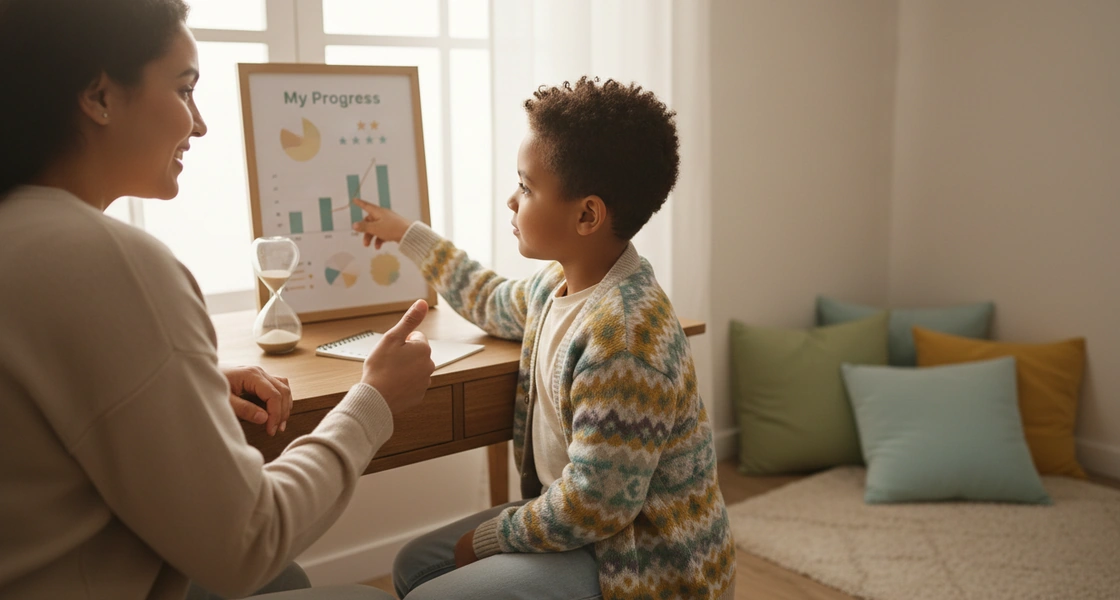Your learner might already be thinking about fractions—when they pour juice, split a snack, or fold paper in half, they’re working with parts of a whole without even realizing it. These everyday experiences are the beginning of real mathematical thinking.
The beauty is that with a little intention, you can build on those everyday moments and guide your child toward deeper understanding through what naturally sparks your learner’s curiosity.
In this guide, you’ll find simple, flexible ways to introduce and practice fractions at home through hands-on activities, relatable examples, and visual tools that stick. If you're looking to deepen that learning, Outschool offers live, small-group classes that bring math to life—all in a friendly, engaging format that fits your family's rhythm.
What learners need to understand about fractions
Fractions can feel like a big leap, but they often start to click during small, real-life interactions. Splitting a snack, pouring just the right amount, or sharing toys—all of these help lay the groundwork for deeper math thinking.
A few key ideas can help your learner get comfortable with fractions early on, especially if they’re able to see those ideas in different ways. Here are some core concepts to keep in mind:
Fractions show parts of a whole: A fraction represents one or more parts of something split into equal pieces. If your learner says “I had half,” they’re already thinking in fractions—1/2 means one piece out of two even portions.
Numerators and denominators: As your learner grows more familiar with fractions, they’ll start to make sense of how they're written. That means understanding that the top number (the numerator) shows how many parts they have, and the bottom number (the denominator) shows how many equal pieces the whole was divided into. For example, in 3/4, the 3 means three parts out of four total. It’s a new layer of understanding, and it builds over time.
Some fractions are equivalent: Learners may be surprised that 2/4 and 1/2 can mean the same thing. These moments of recognition are a big step toward deeper understanding.
Comparing different fractions: Understanding which fractions are bigger or smaller, like figuring out that 1/3 is less than 1/2, doesn’t always come naturally. It’s a subtle concept that takes time to develop, especially when the numbers don’t look very different. This kind of reasoning often builds through repeated exposure and exploration.
You don’t have to cover everything at once. Just coming back to these ideas now and then—through play, conversation, or daily life—can help your learner feel more confident each time.
3 Simple ways to explore core fraction concepts
Once your learner starts getting the idea of what a fraction is, it helps to try it out in a few different ways. The approaches below each do something a little different—one helps with visuals, one builds vocabulary, and one gets your learner thinking more flexibly. You can mix and match based on what feels like a good fit for the moment.
1. Explore with real-life examples
Using real situations gives your learner something familiar to work with. These moments can turn into quick, natural ways to talk about fractions while taking away the pressure of a formal lesson.
- Use measuring cups while cooking
It’s an easy way to see how fractions fit together. Your learner gets to pour, compare, and see what happens when you add different amounts.
- Cut food into equal parts and talk about what each piece means
A sandwich cut in half or an apple split into thirds turns into a quick moment to talk about equal parts in a real-life setting.
- Divide screen time, snacks, or turns with toys
Sharing helps learners think about how to split things fairly, and what it actually means to get “half” or “a third.”
2. Use visual and tactile tools
Your learner might not connect with numbers right away. Having something they can see, hold, or move around gives them another way to work through the idea.
- Build fraction walls with paper strips or blocks
Create strips of paper that are the same length but divided into different numbers of equal parts—like halves, thirds, fourths, and so on. Lay them out side by side so your learner can see how different fractions compare in size.
This makes it easier to grasp ideas like equivalence (e.g., 2/4 = 1/2) and to visualize why some fractions are bigger than others, even if their numbers are smaller.
- Fold paper and color in a few sections
Folding a piece of paper in half, thirds, or quarters gives a simple, hands-on way to show what “equal parts” really means. Once folded, coloring in a few sections helps reinforce what a specific fraction looks like.
For example, shading in one part of a paper folded into four helps make the idea of 1/4 feel more concrete—and helps learners start connecting visual models to written fractions.
- Use playdough, LEGO bricks, or whatever’s on hand
Manipulatives like playdough or LEGOs let learners build, break apart, and reassemble shapes to see how parts make up a whole. Rolling playdough into a ball and dividing it into chunks or using same-size LEGO bricks to represent parts of a set shows that fractions are about spatial reasoning, too.
3. Practice comparing and building equivalents
Once your learner gets the basics, you can start playing around with how fractions relate to each other. That might mean figuring out which ones are bigger, or spotting when two different-looking ones are actually the same.
- Ask questions like “Which is bigger: 1/3 or 1/2?”
These quick little “hmm…” moments get them thinking beyond just naming the fraction. They’re starting to look at size and how the pieces actually compare.
- Show them how something like 2/4 is the same as 1/2
A simple way to do this would be to just line up strips of paper and talk it through. Seeing it side by side can help things start to click.
- Turn it into a game
Matching cards, memory puzzles, or using dice to practice writing fractions can keep things fun while still giving them the practice they need.
Hands-on activities to build understanding
Sometimes the best way to understand fractions is to get hands-on with them. Cutting, folding, building, coloring—these simple activities can help your learner see what fractions really mean.
Build a fraction wall
This one’s super hands-on and surprisingly fun.
- Cut strips of paper into equal parts—halves, thirds, fourths, or more.
- Label each piece with its fraction (like 1/2 and ½ or 1/3, 1/3, 1/3, etc.).
- Stack them to compare sizes and see how different fractions relate.
Your learner will start to notice that two 1/4 pieces take up the same space as one 1/2. It’s a simple way to make equivalence and comparison feel intuitive.
Create fraction art
This is perfect for learners who love to draw or use color.
- Draw or cut out shapes (circles, squares, hearts—whatever inspires them).
- Divide each shape into equal parts.
- Color a few sections to match a fraction (like 2 out of 4 or 3 out of 6).
This builds visual recognition and gives your learner a creative way to express what they’re learning.
Try a fraction scavenger hunt
Start bringing up fractions at random times during the day, to help your learner come out of ‘lesson mode’ and apply their learnings in practical life.
- Look for examples around the house: folded towels, pizza slices, measuring cups, broken crackers.
- Ask your learner questions like “How many total parts are there?” or “What part of the whole do we have?”
- Snap a photo or draw what you find to build a little fraction collection.
Play fraction games
Games are a fun way to build fluency without it feeling like extra work.
- Try bingo, memory cards, or printable fraction puzzles.
- Use dice to generate fractions and compare them (if you roll a 2 and a 4 = 2/4).
- Make your own game with index cards, snack pieces, or LEGO bricks.
As long as they’re thinking, talking, and comparing, it counts as great practice!
Resources to support learning
Different learners click with different things—some love to build and play, others do better with visuals or a bit more structure. This toolkit has a little of everything, so you can try out what works best for your learner. From games and books to digital tools and full programs, it’s all easy to mix, match, and use at your own pace.
Play-based books and games
If you’re looking to engage your learner, play-based books are a great way to go. Bonus points if your learner lights up during storytime or loves friendly competition, these easy wins will also boost their confidence with numbers.
- The Hershey's Milk Chocolate Fractions Book by Jerry Pallotta
- Fraction Fun by David A. Adler
- Whole-y Cow! Fractions Are Fun by Taryn Souders
- Pizza Fraction Fun Game (Learning Resources)
Visual models and manipulatives
For some learners, seeing how parts fit together is what really makes fractions click. These tools let your learner build, move, and rearrange pieces—helping them make sense of it all in a more hands-on way.
- Printable paper fraction circles
- Color-coded fraction strips or tiles
- Mathigon Polypad – an interactive online tool that lets learners experiment with fraction tiles and number lines
Structured programs for home
If you're looking for a more consistent approach—or just want something you can follow without having to plan too much—these programs include fraction practice as part of a full math curriculum.
Outschool Small-group classes and clubs
Sometimes it helps to learn with other kids, and hear someone else explain the concept in a new way. Outschool’s live classes mix games, visuals, and real-time guidance so your learner can ask questions, share ideas, and stay engaged.
- Fraction Fun: A playful, one-time class using hands-on activities to introduce basic fraction concepts.
- Fraction Fluency: A flexible, self-paced course that builds strong foundational skills through engaging video lessons and activities.
- Weekly Fraction Fun Club: A live, ongoing class where learners practice fractions through games, challenges, and collaborative problem-solving.
Talking through fractions with your learner
Some of the most helpful learning moments happen in the middle of everyday conversations. A quick explanation here, a simple comment there—it all adds up. When you talk through what’s happening, you’re helping your learner understand fractions in a way that feels clear and approachable. Here are a few ways to make those moments count.
Use simple, everyday language
Clear, everyday language can really help your learner understand what a fraction actually means. You don’t need to turn everything into a formal lesson—just talking about what you’re doing at the moment can help make the ideas stick.
If you’re cutting paper, slicing a snack, or measuring ingredients, you might say things like:
- “We’re splitting it into equal parts.”
- “You’ve got one piece out of three.”
- “The top number tells how many pieces we have. The bottom number tells how many we started with.”
Simple phrases like these make fraction ideas easier to grasp—especially when your learner is just starting out.
- "We're cutting it into even portions."
- "You have one out of three pieces."
- "The top number tells us how many we have, and the bottom number tells us how many it was split into."
Once your learner feels comfortable, you can introduce terms like "numerator" and "denominator."
Introduce terms when it feels natural
Once your learner seems comfortable talking about fractions, you can start weaving in the more official math words. No need to stop and explain everything—just use terms like numerator or denominator here and there as they come up. Over time, they’ll start picking up what those words mean just by hearing them.
Give bigger concepts time to settle in
Things like comparing fractions or realizing that 1/2 and 2/4 are the same amount can take a while. These ideas are a bit less obvious, that’s why it’s completely normal if your learner needs more time, or a different way of looking at it.
If your learner’s getting stuck, it might help to try something new—like one of the approaches we talked about earlier. A quick visual, a real-life example, or even turning it into a game can open things up in a different way. It doesn’t have to be complicated—just something that feels a little different from what they’ve already seen.
What fraction progress can look like
Fraction skills don’t usually come together all at once, and that’s totally normal. With a bit of practice and a mix of different experiences, your learner will start to make sense of things in their own way. This isn’t a step-by-step checklist, but it might give you a general feel for how their understanding could grow over time.
Spotting parts of a whole
Maybe they point out that their sandwich is cut in half, or that they only got one slice out of four. These early observations are often a sign that they’re starting to see how things break into parts.
Trying out equal shares
You might catch them folding paper to share it “evenly” or cutting a snack and asking if it’s fair. This kind of experimenting helps them make sense of what equal parts really mean.
Getting the hang of fraction names
Terms like “one-half” or “one-fourth” start to sound familiar. They may begin connecting what they see—like shaded pieces or split objects—to how those amounts are named.
Starting to understand the numbers
At some point, your learner might ask what the top or bottom number means. That’s a sign they’re beginning to understand that the top (numerator) tells how many parts they have, and the bottom (denominator) shows how many parts the whole was split into.
Comparing and connecting
Over time, they’ll probably start making connections—like realizing that 2/4 and 1/2 are the same, or trying to figure out which is bigger: 1/3 or 1/2. These moments show they’re thinking more deeply about how fractions relate to each other.
Common questions parents ask about fractions
Even with plenty of support, you’ll have moments where you’re not quite sure what to say—or what to do next. To make things a little easier, we’ve put together a few common questions parents run into, plus some ideas for how to handle them as they come up.
How do I know if my learner is ready for fractions?
Readiness doesn't always show up as formal math skills. If your learner starts talking about "half" of a cookie, noticing how things are shared, or asking why two pieces aren't the same size, they're already thinking in fraction-like ways. That's a great starting point.
Do I need to correct my learner if they get a fraction wrong in play?
Not always. Play-based exploration is about building comfort and curiosity. If your learner says something like "This is one-third" when it's not, try gently guiding them with a follow-up like, "Hmm, let's see how many equal parts we have." Keep it light—it's okay for things to be a little messy as they learn.
Is it okay to stick with just a few fractions for a while?
Absolutely. Mastering key fractions like ½, ⅓, and ¼ can go a long way. Repeated exposure builds confidence, and your learner will be better equipped to understand more complex fractions.
What should I do if my learner says fractions are boring?
Try connecting fractions to something they already love—like baking, building, music, or sports. The more relevant it feels, the more likely they will stay curious and engaged.
Supporting long-term understanding
You don't need to be a math expert to support your learner's fraction learning. What helps most is staying flexible, keeping it playful, and finding ways to connect the ideas to your everyday life.
You’ll keep running into fractions as your learner grows—during meals, projects, games, or even just everyday questions. Coming back to these ideas now and then gives your learner a chance to grow their understanding at their own pace—and reminds them that it's okay to keep figuring things out as they go. If you're looking for extra support, Outschool’s live, small-group math classes have options to match your learner's level, goals, and learning style.


.svg)
.svg)







